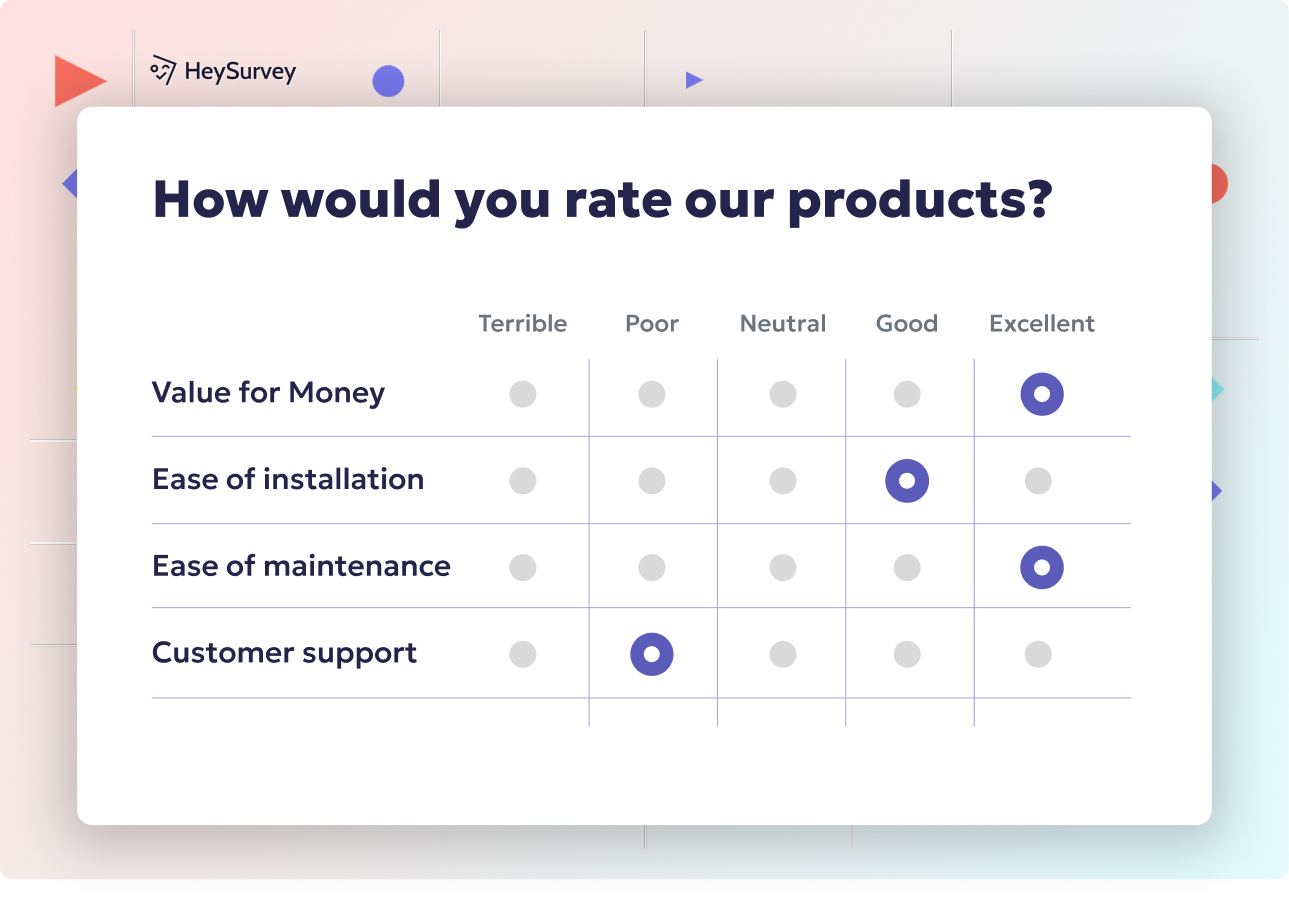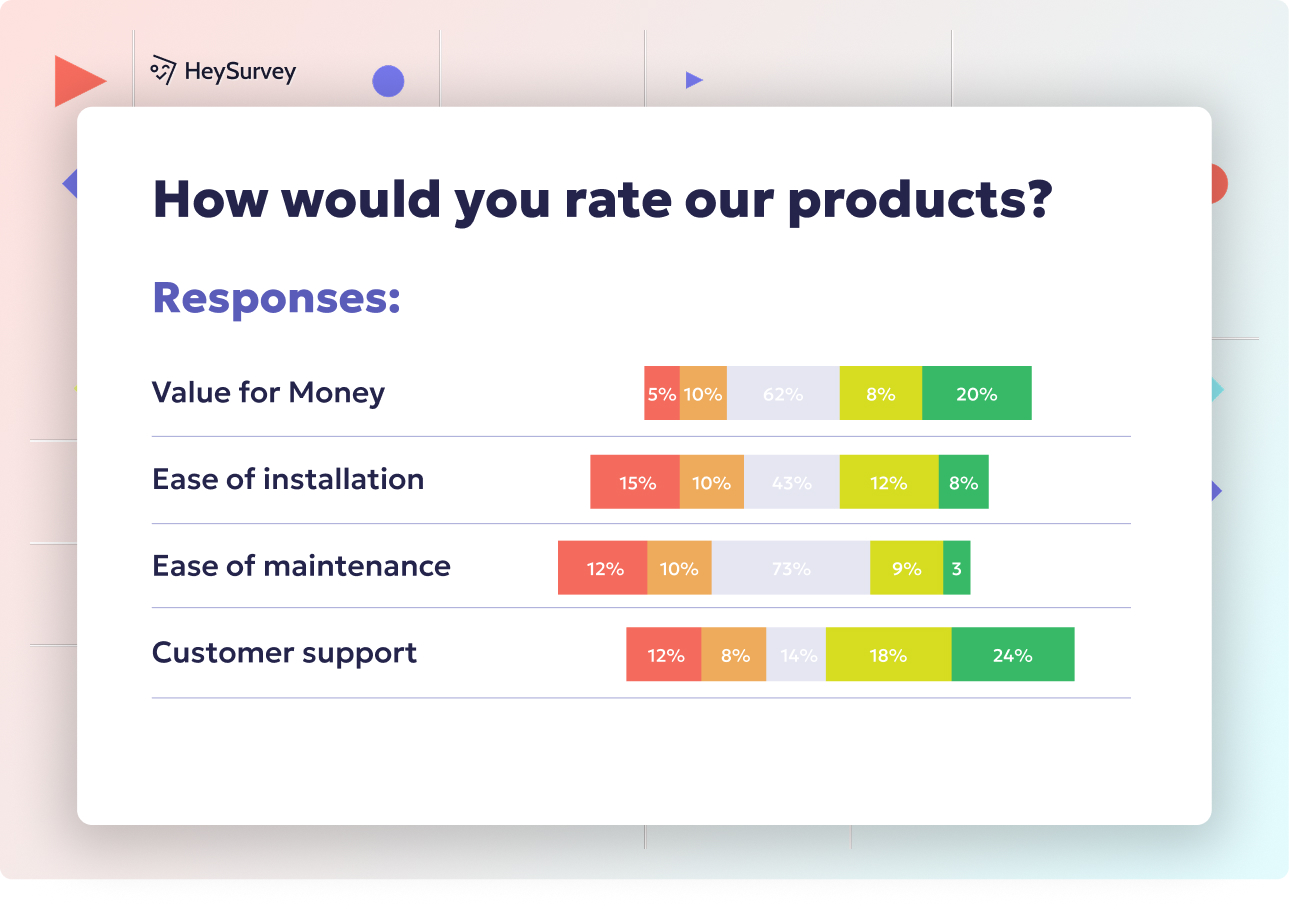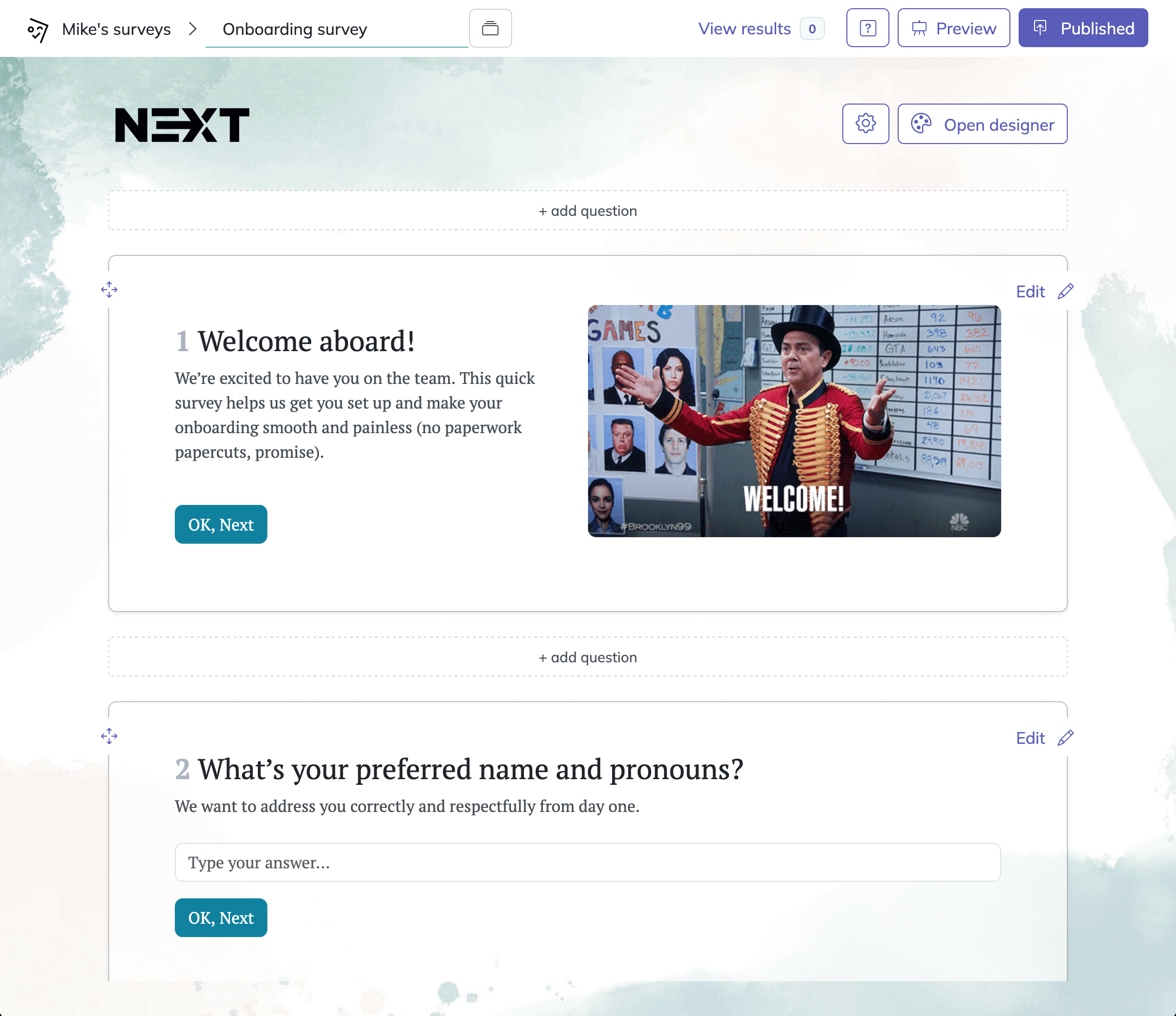31 Employee Retention Survey Questions to Reduce Turnover
Discover 30+ insightful employee retention survey questions across onboarding, engagement, stay, pulse, manager, career growth, and exit surveys.
If you’re wondering how to reduce turnover and keep top talent, deploying the perfect set of employee retention survey questions might just be your superpower. These surveys don’t just tell you who’s happy—they reveal why folks stay, where things go sideways, and how you can fix it. Unlike generic engagement surveys, retention surveys dial in on the real reasons people walk or stick around, helping organizations save cash on replacing staff, boost culture, and keep productivity humming. Time these surveys right—onboarding, 90 days in, quarterly, every year, or exit stage left—and you’ll create a feedback loop employees trust. Below, you’ll find smart survey types and sample questions for every milestone.
Onboarding Retention Survey
Why & When to Use
The first 30 to 90 days of an employee’s journey are crucial for setting the tone and nipping early turnover in the bud. An onboarding retention survey, sometimes called a new hire retention survey, is your backstage pass to learning how new team members experience your company.
This survey shines when you want to:
- Compare recruitment promises with workplace reality to see if you’re really walking your talk.
- Gauge training effectiveness so new hires don’t feel like they’re swimming with the sharks.
- Spot mismatches in cultural fit before they snowball into first-year turnover.
- Catch the quiet signs of disengagement before you’re met with another surprise resignation.
Drop these surveys at the end of the first week, again at 30 days, and once more around 90 days. This cadence gives you early warning signs of potential churn and lets you course-correct before a new hire becomes another statistic.
When you really nail these early touchpoints, you demonstrate that you’re invested in employees from day one. That sends a powerful message: “Stick around—we’re in this together.”
5 Sample Questions
How closely does your role match the expectations set during hiring?
Which part of the onboarding process felt least helpful?
Do you have access to the tools and resources needed to perform your job?
How welcomed do you feel by your team on a scale of 1–10?
What, if anything, might prompt you to leave in the next six months?
With these thoughtful onboarding retention survey questions, you build a culture of openness that can dramatically cut first-year turnover.
A 2023 Paychex study found that 80% of employees who felt undertrained during onboarding planned to quit soon, highlighting the critical role of effective onboarding in retention. (xref.com)

How to Create Your Employee Retention Survey with HeySurvey in 3 Easy Steps
If you’re new to HeySurvey and want to build your very first employee retention survey, here’s a smooth, no-fuss guide to get you rolling — plus a couple of bonus tips to make your survey shine.
Step 1: Create a New Survey
- Head over to HeySurvey and click the button below these instructions to open a ready-made employee retention survey template.
- Alternatively, if you want a fresh start, you can select “Create New Survey” and choose either an empty sheet or start from a pre-built template matching your needs.
- Give your survey a clear internal name so you can find it easily later (something like “Employee Retention Survey June 2024” works great).
This first step sets your survey’s foundation. Starting with a template is especially handy if you want to save time and skip the blank-canvas jitters.
Step 2: Add Your Employee Retention Survey Questions
- In the Survey Editor, hit the Add Question button.
- Choose the question type that fits best (text input, single choice, multiple choice, scale, etc.).
- Copy in your employee retention survey questions or customize pre-loaded ones to exactly match your goals.
- Make questions required if you want to ensure no one skips critical info.
- Use markdown formatting if you want to bold, italicize, or list items within your questions for clarity.
Pro tip: Feel free to add images or helpful descriptions alongside questions to make things more engaging and clear!
Step 3: Publish and Share Your Survey
- Once your questions are locked in, click Preview to see how your survey looks on desktop and mobile devices.
- When you’re happy with the flow and design, hit Publish (you’ll need to create a free HeySurvey account if you haven’t yet).
- Copy the shareable link and send it out to your employees via email, intranet, or embed it in your HR portal.
Publishing unlocks the powers of real-time response tracking, result summaries, and data exports so you can analyze what matters.
Bonus Steps to Make Your Survey Stand Out
- Apply Branding: Upload your company logo and customize colors/fonts in the Designer Sidebar so the survey feels like part of your culture.
- Define Settings: Head to the settings panel to:
- Set start and end dates for survey availability
- Cap the number of responses if needed
- Set a custom thank-you redirect URL after completion
- Decide if respondents can view summarized results
- Set start and end dates for survey availability
- Skip Into Branches: Use advanced branching to tailor follow-up questions based on earlier responses. For example, if someone says they feel unsupported, you can automatically ask for more details.
These bonus steps help you create a professional, branded, and dynamic employee retention survey that really connects.
Creating your employee retention survey with HeySurvey is a breeze, even if you’re a first-timer. Ready to jump in? Click the button below to start with a handy template and make employee retention a priority today!
Engagement & Satisfaction Survey
Why & When to Use
When morale dips, productivity slips out the door right behind it. An employee engagement and satisfaction survey is your check engine light for morale, work-life harmony, and psychological safety—all of which shape whether people stay for the long haul.
These surveys are usually given annually or twice a year, providing a detailed snapshot of:
- Everyday workload balance to ensure people aren’t burning out or losing steam.
- Sense of meaning, belonging, and accomplishment that ties employees emotionally to your mission.
- Overall job satisfaction—because no one sticks around when they’re counting down the days.
The key phrase here is psychological safety. When folks feel safe, seen, and heard at work, they’re less likely to spend their lunch breaks updating their resumes.
By making engagement and satisfaction questions a routine part of your yearly calendar, you send the message that employee voice matters. Small improvements based on their feedback add up to big increases in retention over time.
5 Sample Questions
How meaningful do you find the work you do?
How confident are you that concerns raised here will be acted upon?
Rate your overall job satisfaction.
Do you see a clear link between your work and the company’s mission?
How likely are you to look for a new job in the next year?
Asking these questions regularly uncovers hidden hiccups in morale so you can reduce turnover and keep employees energized.
Regularly conducting employee engagement and satisfaction surveys can significantly enhance retention by identifying and addressing factors that influence employees' decisions to stay or leave. (quantumworkplace.com)
Stay (Intent-to-Remain) Survey
Why & When to Use
A stay survey—sometimes called an intent-to-remain survey—is your crystal ball for predicting loyalty. Instead of wondering who’s about to fly the coop, you get direct answers about what’s working and what needs fixing.
Ideal survey timing includes:
- At the middle of the year, when annual reviews (and restlessness) start to simmer.
- After significant leadership changes, restructures, or mergers—events that can churn even your most steadfast employees.
The magic of a stay survey is in its proactivity. You don’t have to scramble when someone turns in their notice. Instead, you’re uncovering reasons to stay and leave long before anyone hits “submit” on a job application.
By using questions that dig into motivators and hesitations, organizations can identify under-the-radar risks and develop targeted strategies that help keep top talent exactly where they are—happy, productive, and planning their next chapter with you.
5 Sample Questions
What motivates you to continue working here?
Which factors would most influence you to consider leaving?
How valued do you feel for the work you do?
Do you see a future career path within this organization?
What one change would increase your likelihood to stay for the next two years?
With these powerful stay survey questions, you’re not just fighting fires—you’re fireproofing your workplace.
Pulse Retention Survey
Why & When to Use
If engagement surveys are your annual physical, pulse retention surveys are your monthly check-up—quick, painless, and laser-focused on preventing trouble before it starts. These fast, focused surveys—usually just 5 to 10 questions—are designed to keep a regular pulse on how everyone’s feeling.
Deploy these surveys monthly or quarterly for:
- Instant read-outs of morale, stress, and support—letting you react in real-time before someone's quietly disengaging.
- Spotting trends that might get lost in annual deep dives.
- Building a rhythm of open, ongoing feedback so employees know you’re always listening.
Pulse retention surveys are perfect for complementing longer surveys and giving you a temperature check. When you notice spikes in stress or dips in recognition, you can act fast, making employees feel seen fast, too.
Plus, these super-quick surveys aren’t a burden; they’re a conversation starter that keeps the two-way street between leadership and staff wide open.
5 Sample Questions
How supported do you feel by your manager this week?
Rate your current stress level.
Do you feel recognized for recent accomplishments?
How confident are you in leadership’s direction right now?
Would you recommend this company as a great place to work today?
By making pulse surveys a habit, you get actionable insights to keep top talent from drifting—without overwhelm.
Regular pulse surveys can lead to a 30% increase in employee retention by providing real-time feedback that addresses issues promptly. (psico-smart.com)
Manager Effectiveness Survey
Why & When to Use
Direct managers are the linchpin of retention. When managers are supportive, clear, and trusted, teams thrive. When they’re not? Let’s just say resumes fly.
A manager effectiveness survey provides 360° feedback that gets at the heart of why people stay or go, ideally run every six months. Think of it as relationship therapy for your company.
Gathering honest input around managers is crucial to:
- Diagnose weak spots in team leadership—nobody wants to feel ignored or micromanaged.
- Spot high-potential leaders worth investing in.
- Pinpoint development opportunities before frustrations boil over into departures.
By using targeted questions and frequent check-ins, you show that great management isn’t optional—it’s expected. And when you take action based on this feedback, loyalty grows on every team.
5 Sample Questions
My manager helps remove obstacles that hinder my work. (Agree/Disagree)
How often does your manager provide constructive feedback?
Do you trust your manager to act in your best interest?
Rate your manager’s communication clarity.
What could your manager do to improve your desire to remain?
When you invest in manager effectiveness surveys, you transform supervisors into retention champions.
Career Growth & Development Survey
Why & When to Use
Career growth and development is the rocket fuel of retention. When employees see a future for themselves at your company, they stick around—and even bring their friends!
These surveys are best sent annually or before performance reviews, when employees are naturally reflecting on their progress and ambitions. Use a career development survey to:
- Check if employees actually have a growth roadmap, or if they feel stuck.
- Gauge satisfaction with learning opportunities so you know where to invest.
- Spark open career conversations between employees and managers.
Lack of advancement is consistently cited as a top reason people leave. By tackling it directly, you make clear that getting a promotion or mastering new skills isn’t a pipe dream—it’s part of your culture.
A regular career growth survey signals to your whole team that you care about more than just today’s performance. You care about their future ambitions, too.
5 Sample Questions
Do you have a clear development plan for the next 12 months?
How satisfied are you with available training opportunities?
Have you discussed career goals with your manager in the last six months?
Do you believe promotions here are fair and transparent?
Which new skills would you like to acquire to grow in your role?
Focused career survey questions like these are your best shot at reducing turnover by fueling internal mobility and satisfaction.
Exit Survey
Why & When to Use
Nothing cuts deeper than goodbyes—unless you use them for growth. An exit survey lets departing employees reflect honestly on what didn’t work and what might have kept them around.
Deploy this survey during the quitting process, when memories and details are still sharp. The feedback you gather here is invaluable for:
- Spotting patterns in why people leave, whether it's poor management, pay, or career stagnation.
- Getting real talk about the culture and processes that send good folks packing.
- Closing the loop for returning “boomerang” employees—because sometimes, the grass isn’t actually greener.
Exit surveys feed key insights back into your retention strategy so you can fix recurring issues, learn from mistakes, and—who knows—maybe even get a few people back someday.
Just remember: Honest answers here are only useful if you’re brave enough to act on them.
5 Sample Questions
What primary reason led you to accept another opportunity?
What could we have done to retain you?
How would you describe your relationship with your manager?
Rate your overall experience working here.
Would you consider returning to the company in the future?
By leveraging exit survey feedback, you turn every goodbye into a chance for stronger retention tomorrow.
Best Practices: Dos and Don’ts for High-Impact Employee Retention Surveys
A great survey is more than just a list of questions—it’s how you ask, interpret, and act. If you want employee retention surveys to shine, here’s the playbook for impact.
DO align each survey’s objective with specific retention KPIs. Know exactly what you want to measure, whether it’s first-year turnover or promotion satisfaction.
DO keep surveys concise and mobile-friendly. Employees should be able to answer on their commute or coffee break—no marathon required!
- Use straightforward, jargon-free language
- Limit surveys to 10–15 questions
- Enable options for mobile and desktop
DO communicate results and action plans quickly to build trust. Silence between surveys and action creates skepticism:
- Share key findings within two weeks
- Outline what’s changing (and what isn’t)
- Update regularly on progress
DON’T collect data you can’t act on. If you’re not ready to fix something, don’t ask. Nothing demotivates faster than ignored complaints.
DON’T rely solely on anonymous surveys—mix with open dialogue. Group discussions, one-on-ones, and suggestion boxes add context and uncover new solutions.
DO segment data (department, tenure, demographics) for targeted interventions. What motivates your sales team may not work for your engineers.
DON’T survey during peak workload periods if avoidable. The last thing burnt-out employees want is another task.
DO benchmark year-over-year to track progress. Use past results, compare across departments, and celebrate improvements.
When you combine these best practices, your surveys become the secret sauce for reducing turnover and building a vibrant workplace.
Conclusion & Next Steps
Mixing up your employee retention survey questions across all career touchpoints gives you a 360° view of why employees stay or go. But remember, data alone won’t move the needle—your action and follow-through will. Rather than waiting for problems to pile up, use every survey as a launchpad for change.
Ready to get started? Download a free retention survey template or schedule a demo with your HR analytics team—your future team will thank you!
Related Employee Survey Surveys

29 Essential Post Mortem Survey Questions for Project Success
Discover 25+ essential post mortem survey questions to improve projects, boost team morale, and d...

31 Change Readiness Survey Questions to Boost Your Success
Discover 25+ sample change readiness survey questions to assess attitudes, barriers, and confiden...

31 Retreat Survey Questions to Collect Actionable Feedback
Discover 26 essential retreat survey questions to gather actionable feedback before, during, and ...


